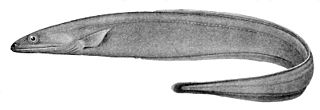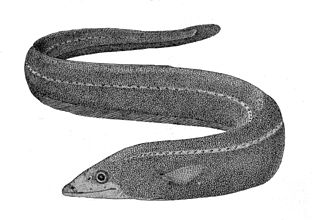
Cutthroat eels are a family, Synaphobranchidae, of eels, the only members of the suborder Synaphobranchoidei. They are found worldwide in temperate and tropical seas.

The grey cutthroat eel, Synaphobranchus affinis, is a cutthroat eel. It was originally described by Albert Günther in 1877. It lives a benthic lifestyle, inhabiting the continental slope and global deep waters including near Portugal, Canary Islands, Morocco, Japan, Australia, and others. It is a marine, deep water-dwelling eel which has been found at depths ranging from 300 to 2300 meters and at temperatures ranging from 3.3 - 11.3 °C. Males can grow to a length of up to 110 centimeters. It is primarily a scavenger, however it also actively hunts small fish and crustaceans.
The snubnosed eel, Simenchelys parasitica, also known as the pug-nosed eel, slime eel, or snub-nose parasitic eel, is a species of deep-sea eel and the only member of its genus. Some authors classify it as the sole member of the subfamily Simenchelyinae of the family Synaphobranchidae, or cutthroat eels, while others place it in its own monotypic family, the Simenchelyidae. It is found in the Atlantic and Pacific Oceans, typically at a depth of 500–1,800 m (1,600–5,900 ft) near the bottom. Although typically a scavenger, it is better known for using its powerful jaws and teeth to burrow into larger fishes as a parasite. This species is harmless to humans and of no interest to fisheries. The generic name Simenchelys translates literally as "pug-nosed eel".

Ilyophis is a genus of marine ray-finned fishes belonging to the family Synaphobranchidae, the cutthroat eels. These eels are found in the Atlantic, Indian and Pacific Oceans.
Haptenchelys is a genus of deep-water eel in the family Synaphobranchidae. It contains two species. It is found in the Atlantic Ocean and Pacific Ocean at depths of 2,121 to 4,836 metres.
Atractodenchelys robinsorum is an eel in the family Synaphobranchidae. It was described by Emma Stanislavovna Karmovskaya in 2003. It is a marine, deep water-dwelling eel which is known from the Chesterfield Islands in the southwestern Pacific Ocean. It is known to dwell at a depth of 710 metres.

Dysomma anguillare, the shortbelly eel, stout moray, mustard eel or arrowtooth eel, is an eel in the family Synaphobranchidae. It was described by Keppel Harcourt Barnard in 1923. It is a marine, tropical eel which is known from the western Atlantic Ocean and Indo-Western Pacific, including the United States, Venezuela, South Africa, Zanzibar, and Japan. It lives at a depth range of 30 to 270 metres, and inhabits muddy sediments in coastal waters and large rivermouths. Males can reach a maximum total length of 52 centimetres (20 in).
Dysomma longirostrum is an eel in the family Synaphobranchidae. It was described by Chen Yu-Yun and Michael Hin-Kiu Mok in 2001. It is a marine, temperate water-dwelling eel which is known from Taiwan, in the northwestern Pacific Ocean. It dwells at a depth range of 100–150 metres. Males can reach a maximum total length of 19.6 centimetres.
Dysomma opisthoproctus is an eel in the family Synaphobranchidae. It was described by Chen Yu-Yun and Michael Hin-Kiu Mok in 1995. It is a subtropical, marine eel which is known only from northeastern Taiwan, in the northwestern Pacific Ocean. It is known to dwell at a maximum depth of 200 metres. Males are known to reach a total length of 42.1 centimetres.

Dysommina rugosa is an eel in the family Synaphobranchidae. It was described by Isaac Ginsburg in 1951. It is a marine, deep water-dwelling eel which is known from the western Atlantic and eastern central Pacific Ocean. It dwells at a depth range of 260–775 metres, and is found off the continental slope. Males can reach a maximum total length of 37 centimetres.
Histiobranchus australis, the southern cut-throat eel is an eel in the family Synaphobranchidae. It was described by Regan in 1913. It is a marine, deep water-dwelling eel which is known from the southern Atlantic, Indian, and Pacific Ocean. It dwells at a depth range of 950 to 3,001 metres, and leads a benthic lifestyle. Males can reach a maximum total length of 62.8 centimetres (24.7 in), while females can reach a maximum TL of 67.0 centimetres (26.4 in).
Ilyophis arx is an eel in the family Synaphobranchidae. It was described by Catherine H. Robins in 1976. It is a marine, deep water-dwelling eel which is known from the eastern Pacific and northeastern Atlantic Ocean. It dwells at a depth range of 1,790 to 3,225 metres. Males can reach a maximum total length of 44.7 centimetres (17.6 in).
Ilyophis blachei is an eel in the family Synaphobranchidae. It was described by Luiz Vieria Caldas Saldanha and Nigel Merrett in 1982. It is a marine, deep water-dwelling eel which is known from the northeastern and southeastern Atlantic and southern Indian Ocean. It dwells at a depth range 580 to 2,070 metres, and inhabits the continental shelf. Males can reach a maximum total length of 79.2 centimetres (31.2 in).
Ilyophis nigeli is an eel in the family Synaphobranchidae. It was described by Yuri Nikolaevich Shcherbachev and Kenneth J. Sulak in 1997. It is a marine, deep water-dwelling eel which is known from Japan, in the northwestern Pacific Ocean. It is known to dwell at a depth range of 700 to 1,800 metres. Males can reach a maximum total length of 51.3 centimetres (20.2 in).
Ilyophis saldanhai is an eel in the family Synaphobranchidae. It was described by Emma Stanislavovna Karmovskaya and Nikolai Vasilyevich Parin in 1999, and is the most recently described of the six species in the genus Ilyophis. It is a marine, deep water-dwelling eel which is known from the western central Atlantic Ocean. It is known to dwell at a depth of 3,020 metres (9,910 ft).
Meadia roseni is an eel in the family Synaphobranchidae. It was described by Michael Hin-Kiu Mok, Chi-Ying Lee, and Hung-Jung Chan in 1991. It is a marine, deep water-dwelling eel which is known from Taiwan, in the northwestern Pacific Ocean. It is known to dwell at a depth of 1,020 metres (3,350 ft). Males can reach a maximum total length of 74.5 centimetres (29.3 in).

The shortdorsal cutthroat eel is an eel in the family Synaphobranchidae. It was described by Albert Günther in 1887. It is a marine, deep water-dwelling eel which is known from the Indo-Pacific and western central Atlantic Ocean, including Zanzibar, Maldives, Australia, Japan, Suriname, and the Gulf of Mexico. It dwells at a depth range of 900 to 3,000 metres, most often between 1,000 to 2,500 metres, and leads a benthic lifestyle, inhabiting the continental slope. Males can reach a maximum total length of 111 centimetres (44 in).
Synaphobranchus calvus is an eel in the family Synaphobranchidae. It was described by Marcelo Roberto Souto de Melo in 2007.

The Kaup's arrowtooth eel is an eel in the family Synaphobranchidae. It was described by James Yate Johnson in 1862. It is a marine, deep water-dwelling eel which is known from the Indo-Western Pacific and eastern and western Atlantic Ocean, including the Faroe Islands, Iceland, Cape Verde, the Western Sahara, Nigeria, Namibia, South Africa, Greenland, France, Saint Pierre and Miquelon, the United Kingdom, Ireland, the Philippines, Portugal, Spain, the Bahamas, Brazil, Canada, Cuba, Japan, Australia, Mauritania, Morocco, and Hawaii. It dwells at a depth range of 120 to 4,800 metres, most often between 400 and 2,200 metres, and inhabits the upper abyssal zone on the continental slope. It is intolerant of the temperatures of higher waters. Males can reach a maximum total length of 100 centimetres (39 in).

Ilyophinae, the arrowtooth ells or mustard eels, is a subfamily of marine ray-finned fishes belongiing to the family Synaphobranchidae, the cutthroat eels. Within its family this subfamily shows greatest number of species and the greatest morphological diversity.





